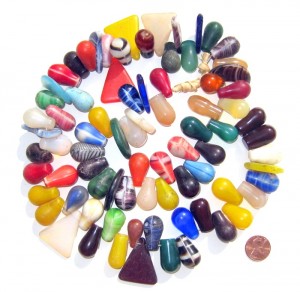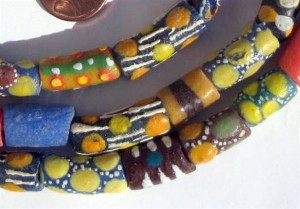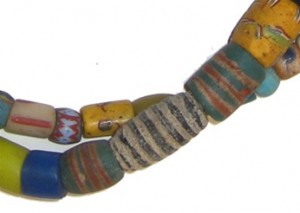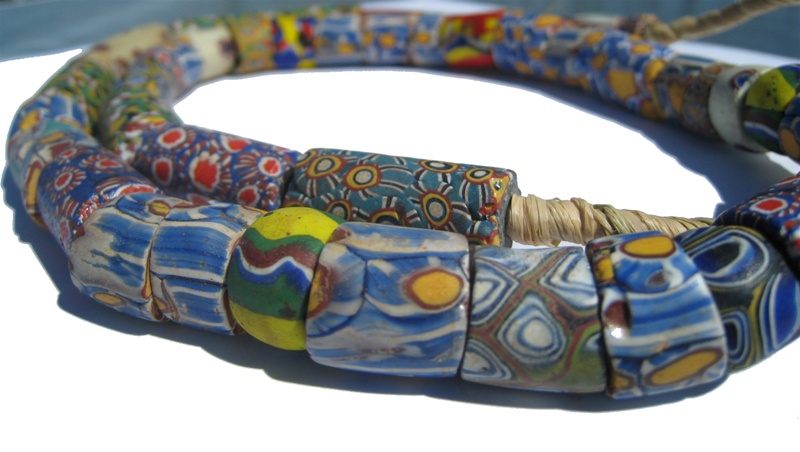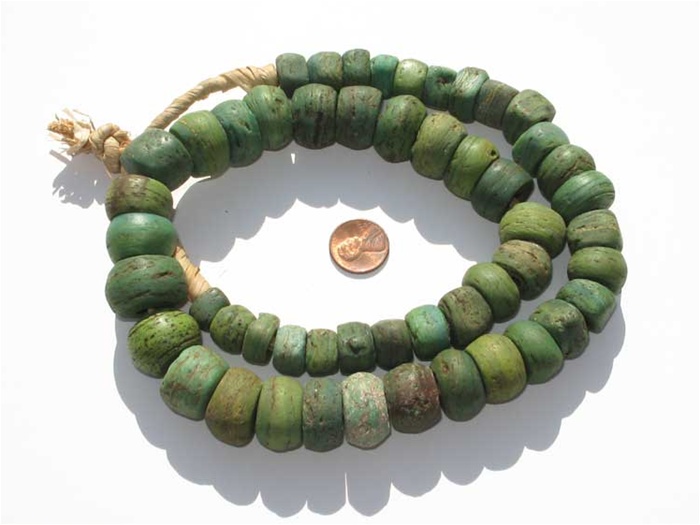Art Seymour: The Man Reviving Chevron Bead Art in Ghana
Art Seymour, the pioneering mind behind the Share The Magic project currently in operation within Odumase Krobo, Ghana, attributes his "passion for glass" to a very early childhood memory. As an impressionable 5 year old, Art enjoyed nothing more than visiting his grandmother's house, particularly due to the fascinating array of curios she had accumulated through her lifetime. One of these would instill an obsession, that later became his sole purpose for breathing. That object was a paper-weight. One of the prism-like desk variety, that most will have at one point or another seen in antique, thrift or charity stores gathering dust.
Fascinated by the intense colours, light refraction and almost "edible" richness created by the colored glass, Art would later find his childhood memory becoming sole inspiration for reviving a long-considered dead art-form - Chevron bead-making.
For those unfamiliar with Chevron beads; they are a product of the merchant trade era, originally produced within Venice, and transported to Africa by merchants plying trade en route to bigger destinations such as the Americas. A type of African trade beads, they are created using the 'cane technique', that is, the adhering of several long glass canes in a step-by-step manner, to create star and stripe beads of magnificent colorings. Such beads became a treasure for the people of Ghana, during a period when Venetian trade beads were regarded as more than just pretty jewelry objects - they were currency!
Art Seymour commenced a revival of Chevron bead-making from his own workshop in Nevada. Already producing Murano-like pieces for ornamental purposes, his expertise led to the experimentation with the cane technique. As word of his expertise spread, so too did interest in his wares for retail, prompting yet another inspiration. Taking Chevron bead creation, back to the country who still regard these beads as treasure. That country was Ghana, and so, the Share The Magic Project was born.
Partnering with an extremely well known Ghanaian bead 'master' known as
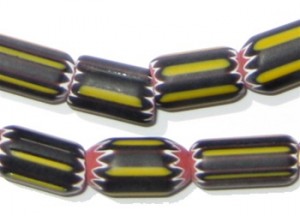
Yellow Jacket Striped Chevron Beads
Nomoda E. Djaba (Cedi bead factory), Art Seymour set about refining a bead production process in 2008, that would utilize the present powder glass bead-making methods currently used in Ghana. The process created brand new molds, setting and cooling techniques through trial and error with two engineering associates on-hand for scientific purposes. This refinement then saw the first of two phases completed, as the lab was packed up and taken to Ghana.
The second phase of Share The Magic Project in March 2008 was funded by the sale of Seymour's bead creations (many limited edition.) The trip was focused upon the building of a "hot glass facility" and education center at Odumase Krobo, that would allow the teaching of Seymour's learned techniques. So the 'Hands Across The Water' phase of Share The Magic was rolled out, and is still in operation today, teaching and providing Ghanaian citizens with the skills to produce stunning multi-colored Chevrons, that are now again, as collectible and prized as they were in the 19th Century!
Vaseline Trade Beads: A Radioactive Discovery?
We are proud to share with you the most comprehensive background on those beautiful beads known as Vaseline trade beads.
The 'radioactive era' as some refer to it was a period between the early
1900's, up to 1930 when a number of distinctive discoveries and advancements influenced an obsession with all things 'radioactive'. It was German chemist Martin Heinrich Klaproth who first discovered Uranium in 1789, however later revelations from French physicist Antoine Becquerel in 1896 proved that Klaproth had not isolated the metallic element - which we now know influences color under ultraviolet light.
Marie and Pierre Curie's work superseded these scientific announcements with the pioneering discovery of Radium in 1898. Interestingly, Marie Curie's work which extended to developing x-ray technology and radiography, won her two Nobel Prize Awards. Her work assisted in helping the treatment of soldiers during World War I, which is probably why she was also the first prize winner to be award two consecutive prizes, for two different types of work - chemistry and physics.
The trend for radioactive chemicals being used for decorative and everyday objects began around 1905. Everything from blown glass vases, to clock-faces, earthenware, pottery and Vaseline Beads were being made with the fluorescing properties of Uranium. Uranium influences an intense yellow-green, or violent green depending upon the kind of light it is subjected to, and appears to glow immensely in ultraviolet light.
Prior to the official discovery of Uranium as an isolated element, the compound was already being used (it is thought) within the production of glass trade beads. Several collections of faceted Vaseline Beads have been discovered, and are thought to date back to the 1830's - all feature the yellow-green characteristics attributed to the Vaseline Beads of the early 1900's. Vaseline Beads are often regarded as a product of Africa, however were first produced within Bohemia - now Czechoslovakia.
The fascination with radioactivity between 1905 and 1915 prompted a period of mass production for Vaseline Trade Beads, and not just within Bohemia. Several other countries, including England and Italy were also caught up with the fascinating properties Uranium salts influenced. Interestingly, it was only a concentration of 1-2% Uranium salts to a glass mold that would offset the chemical reaction that produces the green-yellow aesthetic.
Authentic Vaseline Beads produced around the late 1800's/ early 1900's are distinct due to their shape. Rondelles and discs were by far the most common shapes, however it is not unusual to uncover some with cut facets. Later replicas of Vaseline Beads were produced without Uranium (since later science also uncovered the possible harmful effects of radiation), and can be found in multiple hues. The Uranium was replaced with oxides or dyes during the molding process, and manual manipulation used to replicate the fluorescing qualities of Uranium.
A Buyers Guide To Mali Trade Beads – What To Look For, What To Avoid
Speckled, marbled, bulbous or triangular. Regardless of their shape, color, size or opalescence, there's no denying that Mali Wedding Beads are some of the most spectacular of African origin. From the simple way they refract and reflect light, to the way they hang when strung as a 'bouquet' for a focal necklace center-piece, Mali Wedding Beads exude a beauty and mystique that often belies their archaic history.
With the surge in popularity of auction sites as a primary means of retail, there has also been a ten-fold increase in the quantity of African beads being sold through these mediums. Mali Wedding Beads, along with Venetian Trade Beads, and African Chevrons comprise some of the most sought-after African bead variants, yet shopping for the 'real deal' has become a lot more challenging.
Why is it so difficult to source genuine Mali Beads?
The primary factor that has led to many questioning the authenticity of Mali Beads (that are not sold through accredited wholesalers and dealers), is the production of replicas and reproductions by both Middle Eastern and Western entities. Mali Wedding Beads can often command quite high prices, particularly if sufficient evidence accompanies them to prove they are of pre-1900 origin, and modern techniques are such, that it can be almost impossible to distinguish a reproduction from a true authentic bead.
Signs of Authenticity
If you've been an avid collector of African trade beads for a while, you will more than likely be familiar with the quality, weight and appearance of such old beads. African trade beads tend to have survived over a Century of exchange, travel, wear and tear to end up with the supplier selling them onto you. As a result, their general appearance, texture, and even structure may have suffered from such long life - characteristics loved by the people that collect them, and often what influences their high value in some cases. Other things to look for, or beware of include:
- Obvious Seams: It's generally very rare to come across Mali Wedding Beads that bear a pronounced or obvious seam. Part of their allure is the inherently smooth, glossy finish. If the Mali Beads you're looking at appear to have a prominent ridge from the bulb to the tip, chances are it is a modern reproduction.
- Threading Holes: Sounds daft doesn't it. Surely any bead should bear a threading hole, given their primary purpose is decorative. You'd be surprised at just how many 'replicas' are sold on a daily basis that do not feature this trademark Mali Bead characteristic! Old Mali Beads always bear a vertical threading hole at the 'head' of the bead (the part narrower than the bulb.) Modern variants are produced with a metal pendant fish-eye attachment or something similar, so that the bead can be used as a single pendant.
- Quantity: Authentic African trade beads are always sold by the string upon which they were sourced, by wholesalers committed to protecting the quality and authenticity of such beads. Such beads are often discovered in this state, and will have remained like this since they were first strung a hundred or so years ago. Sellers who break down African trade beads are usually those selling them on auction sites, out to make a quick profit with little regard for the authenticity, and historic relevance of keeping beads together.
- Number in Stock: Authentic trade bead retailers will usually be happy to inform you of the likelihood of certain beads coming back into stock, as well as their sources of stock. An extremely high number of 'bead strings' being sold through an independent dealer (particularly through marketplaces or auction sites) is indicative that they may not be genuine. Accredited dealers rarely have surplus. In fact, they tend to sell out of their authentic wares within days of it's arrival. Due to sourcing direct from Africa, it may also be a wait before such stock reappears upon their store catalog.
Other than the above, you should expect real Mali Wedding Beads to feature signs of wear and age. They may appear dirty, pitted, scratched, worn and even sun-bleached in some cases - all characteristics that indicate age, wear and extensive travel from one person to another. When your Mali Beads arrive, don't be disappointed to find them in such condition - it's part and parcel of their history, genuine character, and most importantly authenticity!
Venetian Trade Beads – Why they are nicknamed ‘talking beads’, by the Ashanti of Africa
Ashante (Asanti), in the heart of Ghana, is a state synonymous with tribal expression and ritual. The Akans (Ashante people) have held precedence as a dominant tribe ever since the 17th Century, when they ruled and controlled most of the 'Gold Coast' (now known administratively as Ghana.) Ghana is also synonymous with the largest level of bead production in Africa, for over 300 years, while the Ashante were the dominating presence, with whom the trade of beads, slaves and goods occurred for over two Centuries.
It is perhaps not surprising then to learn, that the Ashanti, like many Ghanaian tribes, have adopted colored glass trade beads, for the purposes of communication, self-expression, religious ritual and customary rites. The Ashante are of a naturalistic faith, believing that every earthly compound, living thing and substance contains the spirit of ancestors, 'nature Gods' or of the great Ashanti Supreme Being (creator) known as 'Nyame'. To this end, many of the present day rituals, rites and customs are still conducted with the belief that ancestral spirits and 'Gods' communicate through nearly every living thing around them - including beads! Hence, why colours, shapes and even the different pitches of beads as they clack together, hold significance as a 'language' to the Ashanti.
The 'talking beads' of Ashante are worn exactly for the purpose of communication. While the colours are significant, it is the different sounds produced by these beads as they knock against one another when worn, that has borne a unique language among the Ashante, and one that only the trained ear can understand.
Talking beads were traditionally, simple strings of mixed Venetian trade beads - however the modern counterparts tend to be made from recycled glass beads. The beads are predominantly worn by women, and girls from the age of eleven upward, a tradition for which the Krobo women are particularly renowned. Many are of the impression that talking waist beads are used primarily by Ashanti women, to attract the attention of men. This is due to the almost cacophonous noise produced when an Ashanti woman walks with a more pronounced, or even deliberately enhanced feminine gait. The swaying of the hips controls to what extent the beads rattle, therefore can also control how much attention is drawn to this area of the body.
Modern Ashante society has changed a little since the tradition for wearing waist beads first came about. These days, they are considered a very on-trend fashion accessory - yet they are still used by many as a subtle communicational tool, particularly through arts such as dance! Modern Ashante women also appear to be in constant competition with one another, with many using bigger beads for their waist adornments, that will produce far more noise! Perhaps now more than ever before, this is actually to generate increased interest from men, albeit in a manner that is competitive, rather than just a subtle 'notice me' exclamation!
Zulu Beads – The Hidden Love Letters of Africa
Bead adornment has long been used for communicative purposes, although it is largely the tribes of Southern Africa whom are renowned for the complexities of this visual communication method. During the thriving merchant era, certain types of trade beads (notably Chevrons) were highly sought after due to their rarity, or intricacy, and would therefore be worn by elders, Royalty and aristocracy to signify wealth, status and governing power.
But African trade beads weren't the only variant that bore significance as a correspondence tool. Zululand, in the heart of South Africa, is also known for a complex 'language', that uses both Zulu beads, and simple symbols such as the triangle, to convey non-verbal messages. The most common use for this communication method, is for love letters, in a society where it was once frowned upon for women to initiate the courting with men.
The Zulu bead language is built around the geometric triangle - each point bearing a significance to marital status, as does the positioning. Typically, if the point faces Southward, this denotes an unmarried woman, whereas if the apex points North, this signifies an unmarried man. Variants on both the orientation of the triangle, it's attachment to another, and the color of beads it is depicted against, all have an influence upon the message conveyed. Seven main bead colors tend to be used within the bead 'language', and although they all have primary meanings (i.e black connoting sadness, dismay and death); secondary definitions and messages can be created, as a result of the context in which Zulu beads are arranged. Different hues also influence context.
The most common colors used within the Zulu code are: green, which can symbolize contentment, yet also convey envy; blue which signifies longevity and faithfulness; red is strength of emotion, so can dictate love or anger; white for purity, honesty and neutrality of spirit; and finally pink, which added emphasis to a promise, and suggestion of fertility.
With such a beautifully simple language at their fingertips, both Zulu men and women found an avenue by which they could discuss and relay affairs of the heart, without doing so in public. The creative arrangement of Zulu beads allowed for more intricate expression, giving birth to several now well known Zulu love poems. One of these is "iNcwadi" ("I-en-che-wadi"), describing black as a depression due to a lover's absence, and green as the "springing of shoots", likened to the birth of love.
Venetian Millefiori “Thousand Flower” Trade Beads
My favorite trade beads are Millefiori trade beads from Africa. Millefiori is a word which literally means "thousand flowers". Millefiori beads are handcrafted beads that have flower designs layered into them. Because they are handmade, each bead is unique. There are no two beads alike.
These beads can run you anywhere from $8 - $60 a piece. They are cherished for their history and age. To many, they are known as "African Trade Beads." Most Millefiori trade beads have traveled multiple contents, including Europe, Africa, and the United States. You can also purchase them by the strand, in which case they run between $80 and $500.
As you can see in the photo above, they are colorful and crafted with such great detail. Each bead is a work of art that should be cherished to the fullest. Millefiori trade beads make great centerpieces for necklaces and jewelry. True, they are quite an investment, but I guarantee, it is well worth it. You can have a lot of fun with these great beads!
Antique Awale Chevron Trade Beads
One very popular type of chevron trade beads are antique awale beads. These old trade beads are usually light blue with brown and dark blue stripes. In relativity to other chevron beads, awale are relatively cheap, typically running you $23 - $49 a strand. Not bad compared to other chevron trade beads, which can run up to $3,000 per bead!
Many people ask us why these beads are called awale (some people spell it awalleh). To be honest, I'm not quite sure. But this is the name that is used by most African traders in the states.
These beads were most likely made in Venice sometime in the 19th century, or very early 20th century. Most of the time, they are found in good condition, but some beads can be cracked or chipped due to age. These trade beads are said to hold some kind of mysterious and romantic connection to the past. The beads measure anywhere from 4mm - 10mm in diameter, and there are usually anywhere from 100 - 180 beads per strand. Some strands run about 24" in length, but they can measure as large as 32" in a strand (if you're lucky).
Top 5 Reasons Why I Love Using Trade Beads in my Jewelry
Many of my fellow jewelers and craftsmen/women often ask about my obsession with trade beads. I use them in nearly every piece of jewelry I create, so it leads many to wonder, what is the significance of trade beads? Why use trade beads? Well, here are my top reasons for using trade beads in my jewelery.
-
Trade Beads are handmade, and made with love.
Unlike most of the beads in the market today, primarily dominated by Indian and Chinese beads, trade beads are each made by hand, with love, the old fashioned way. It feels nice knowing you are wearing something that was not made by a machine or robot, but rather, by a fellow human 🙂
-
Each bead is one of a kind.
Because trade beads are handmade, every single bead is unique and one of a kind. There are no two beads that are exactly the same! This is particularly noticeable when shopping for Millefiori beads and Venetian trade beads.
-
Wearing trade beads is like wearing a piece of history.
Trade beads date back as some of the oldest beads in modern history. Most trade beads have traveled at least three continents, and have been possessed by multiple owners, especially old trade beads. There's nothing like wearing a piece of history!
-
Shopping for trade beads is fun!
Shopping for trade beads is unlike shopping for most of other types of beads. Because every bead is handmade and one of a kind, shopping never gets old. You never see the same thing twice.
-
Trade beads are usually part of the fair trade.
Most trade beads are considered "fair trade beads", meaning the craftsmen, craftswomen, and artisans involved in creating the beads were not exploited in the process of bringing these beads to you. They are paid the amount they deserve. You know that when you purchase fair trade beads, you are helping to improve the lives of the people who made these beads for you.
Of course, these are only five of the many reasons why I love to use trade beads when creating jewelry. Their significance is unprecedented, and they are the most cultured of beads.
Why do you use trade beads in your jewelry? Post a comment below and share!
Beautiful Venetian Green Heart Trade Beads
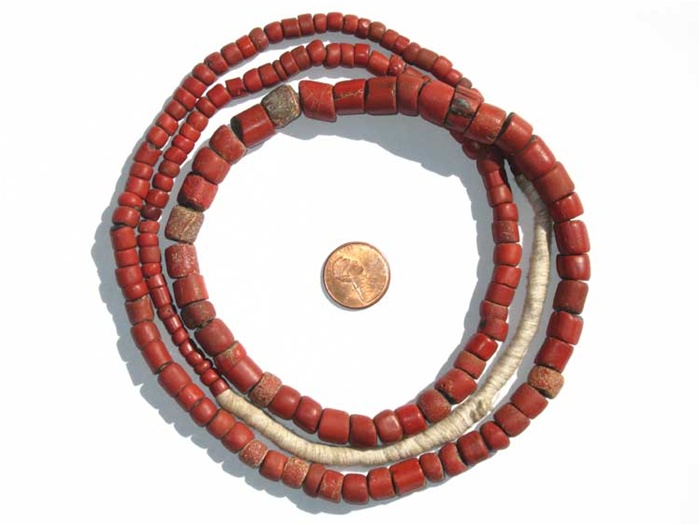 Today, many bead collectors and artisans enjoy using African white heart beads in their jewelry. White heart beads are more commonly known as Hudson Bay Trade Beads. These glass beads have a colored, translucent outside (usually red, turquoise, green, or yellow), and a white center, hence the name "white heart" beads.
Today, many bead collectors and artisans enjoy using African white heart beads in their jewelry. White heart beads are more commonly known as Hudson Bay Trade Beads. These glass beads have a colored, translucent outside (usually red, turquoise, green, or yellow), and a white center, hence the name "white heart" beads.
People often asked, where did white heart beads come from? Where did they evolve from? The somewhat surprising answer: Venetian green heart trade beads. These venetian beads, shown above, have a beautiful mud-colored outside, and a green center core on the inside. Usually, these beads are old, and were made between the 17th and 19th centuries. The strands typically measure over 30 inches long of trade beads, and run for about $30.
These amazing antique green heart trade beads would make a great addition to your next beading project!
Green Hebron Kano Trade Beads from Sudan
Very few African trade beads come from Sudan. But Hebron beads are one of the few that do. Also known as "Kano beads", they come in several different colors and varieties. The most common are yellow hebron beads, followed by blue hebron beads, then green hebron beads. Occasionally, collectors will come across a strand of mixed polka dot Hebron beads, but these will run $300 and upwards, per strand.
Hebron beads are said to be made with salts from the Dead Sea. The Dead Sea, located in Israel, is the saltiest sea on earth, as well as the lowest point on Earth. It is known for its ability to keep people floating, and is a top tourist attraction in the Middle East.
Green hebron trade beads date back to the mid 19th century and earlier. This is why they are a favorite of antique bead collectors. Strands can come in a graduated form, in which the beginning of the strand holds the smallest beads, and the size of the beads graduate larger and larger as you go further down the strand. Or they can come in a uniform style, in which all hebron beads are the same size and shape.
Green hebron beads typically run for $150+ per strand, or approximately $18 per bead. They are often difficult to come by, but are available on many online trade bead stores.
Use these beautiful Sudanese trade beads in your next beading project!

